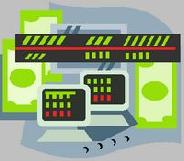
 |
|
| Financial Terms | |
| EBDDT - Earnings before depreciation and deferred taxes |
|
Information about financial, finance, business, accounting, payroll, inventory, investment, money, inventory control, stock trading, financial advisor, tax advisor, credit.
Main Page: money, accounting, stock trading, credit, finance, payroll, tax advisor, financial, |
Definition of EBDDT - Earnings before depreciation and deferred taxes
EBDDT - Earnings before depreciation and deferred taxesThis measure is used principally by
Related Terms:Accelerated depreciationAny depreciation method that produces larger deductions for depreciation in the Accounting earningsearnings of a firm as reported on its income statement. Asymmetric taxesA situation wherein participants in a transaction have different net tax rates. Before-tax profit marginThe ratio of net income before taxes to net sales. Cash flow after interest and taxesNet income plus depreciation. Contingent deferred sales charge (CDSC)The formal name for the load of a back-end load fund. Deferred callA provision that prohibits the company from calling the bond before a certain date. During this  Deferred equityA common term for convertible bonds because of their equity component and the Deferred futuresThe most distant months of a futures contract. A bond that sells at a discount and does not Deferred nominal life annuityA monthly fixed-dollar payment beginning at retirement age. It is nominal Deferred taxesA non-cash expense that provides a source of free cash flow. Amount allocated during the Deferred-annuitiesTax-advantaged life insurance product. deferred annuities offer deferral of taxes with the DepreciationA non-cash expense that provides a source of free cash flow. Amount allocated during the Depreciation tax shieldThe value of the tax write-off on depreciation of plant and equipment. Double-declining-balance depreciationMethod of accelerated depreciation. EarningsNet income for the company during the period.  Earnings before interest and taxes (EBIT)A financial measure defined as revenues less cost of goods sold Earnings per share (EPS)EPS, as it is called, is a company's profit divided by its number of outstanding Earnings retention ratioPlowback rate. Earnings surprisesPositive or negative differences from the consensus forecast of earnings by institutions Earnings yieldThe ratio of earnings per share after allowing for tax and interest payments on fixed interest Economic earningsThe real flow of cash that a firm could pay out forever in the absence of any change in Fully diluted earnings per sharesearnings per share expressed as if all outstanding convertible securities Low price-earnings ratio effectThe tendency of portfolios of stocks with a low price-earnings ratio to Price/earnings ratio (PE ratio)Shows the "multiple" of earnings at which a stock sells. Determined by dividing current Retained earningsAccounting earnings that are retained by the firm for reinvestment in its operations; Single-premium deferred annuityAn insurance policy bought by the sponsor of a pension plan for a single Straight line depreciationAn equal dollar amount of depreciation in each accounting period. Sum-of-the-years'-digits depreciationMethod of accelerated depreciation. Tax-deferred retirement plansEmployer-sponsored and other plans that allow contributions and earnings to DepreciationA technique by which a company recovers the high cost of its plant-and-equipment assets gradually during the number of years they’ll be used in the business. depreciation can be physical, technological, or both. Earnings per share of common stockHow much profit a company made on each share of common stock this year. RETAINED EARNINGSProfits a company plowed back into the business over the years. Last January’s retained earnings, plus the net income or profit that a company made this year (which is calculated on the income statement), minus dividends paid out, equals the retained earnings balance on the balance sheet date. STRAIGHT-LINE DEPRECIATIONA depreciation method that depreciates an asset the same amount for each year of its estimated DepreciationAn expense that spreads the cost of an asset over its useful life. Earnings before interest and taxes (EBIT)The operating profit before deducting interest and tax. Earnings before interest, taxes, depreciation and amortization (EBITDA)The operating profit before deducting interest, tax, depreciation and amortization. Profit before interest and taxes (PBIT)See EBIT. Accumulated depreciationA contra-fixed asset account representing the portion of the cost of a fixed asset that has been previously charged to expense. Each fixed asset account will have its own associated accumulated depreciation account. Depreciation expenseAn expense account that represents the portion of the cost of an asset that is being charged to expense during the current period. Payroll taxes payableThe amount of payroll taxes owed to the various governments at the end of a period. Retained earningsThe residual earnings of the company. Statement Retained EarningsOne of the basic financial statements; it takes the beginning balance of retained earnings and adds net income, then subtracts dividends. The Statement of Retained earnings is prepared for a specified period of time. accelerated depreciation(1) The estimated useful life of the fixed asset being depreciated is accumulated depreciationA contra, or offset, account that is coupled basic earnings per share (EPS)This important ratio equals the net depreciationRefers to the generally accepted accounting principle of allocating diluted earnings per share (EPS)This measure of earnings per share earnings before interest and income tax (EBIT)A measure of profit that earnings per share (EPS)See basic earnings per share and diluted earnings per share. net income (also called the bottom line, earnings, net earnings, and netoperating earnings) price/earnings ratio (price to earnings ratio, P/E ratio, PE ratio)This key ratio equals the current market price straight-line depreciationThis depreciation method allocates a uniform Basic Earnings Power RatioPercentage of earnings relative to total assets; indication of how Earnings per ShareA measure of the earnings generated by a company on a per Price to Earnings Ratio (P/E, PE Ratio)A measure of how much investors are willing to pay for each dollar deferred compensationpay related to current performance tax benefit (of depreciation)the amount of depreciation deductible for tax purposes multiplied by the tax rate; tax-deferred incomecurrent compensation that is taxed at a future date tax shield (of depreciation)the amount of depreciation deductible DepreciationReduction in value of fixed or tangible assets over some period Accelerated depreciationAny of several methods that recognize an increased amount Accumulated depreciationThe sum total of all deprecation expense recognized to date DepreciationBoth the decline in value of an asset over time, as well as the gradual Retained earningsA company’s accumulated earnings since its inception, less any distributions to shareholders. Statement of retained earningsAn adjunct to the balance sheet, providing more detailed information about the beginning balance, changes, and ending balance in depreciation tax shieldReduction in taxes attributable to the depreciation allowance. price-earnings (P/E) multiple (ratio)Ratio of stock price to earnings per share. retained earningsearnings not paid out as dividends. straight-line depreciationConstant depreciation for each year of the asset’s accounting life. Depreciationa) Of capital stock: decline in the value of capital due to its wearing out or becoming obsolete. Depreciation AllowancesTax deductions that businesses can claim when they spend money on investment goods. Indirect Taxestaxes paid by consumers when they buy goods and services. A sales tax is an example. Roth IRA. An IRA account whose earnings are not taxable at all under certaincircumstances. Abusive Earnings ManagementThe use of various forms of gimmickry to distort a company's true financial performance in order to achieve a desired result. Abusive Earnings ManagementA characterization used by the Securities and Exchange Adjusted EarningsNet income adjusted to exclude selected nonrecurring and noncash items of reserve, gain, expense, and loss. Core EarningsA measure of earnings that includes only the results of the primary operating Cost Plus Estimated Earnings in Excess of BillingsRevenue recognized to date under the percentage-of-completion method in excess of amounts billed. Also known as unbilled accounts Deferred Income Tax ExpenseThat portion of the total income tax provision that is the result Deferred Tax AssetFuture tax benefit that results from (1) the origination of a temporary difference Deferred Tax LiabilityFuture tax obligation that results from the origination of a temporary DepreciationThe systematic and rational allocation of the cost of property, plant, and equipment Earnings Before Interest, Taxes, Depreciation, and Amortization (EBITDA)An earningsbased measure that, for many, serves as a surrogate for cash flow. Actually consists of working Earnings ManagementThe active manipulation of earnings toward a predetermined target. EBBS - Earnings before the bad stuffAn acronym attributed to a member of the Securities and Operating EarningsA term frequently used to describe earnings after the removal of the Operational Earnings ManagementManagement actions taken in the effort to create stable Premanaged Earningsearnings before the effects of any earnings-management activities. Pro-Forma EarningsReported net income with selected nonrecurring items of revenue or gain Real Actions (Earnings) ManagementInvolves operational steps and not simply acceleration Sustainable EarningsReported earnings that have had the after-tax effects of all material Deferred AnnuityAn annuity providing for income payments to commence at a specified future time. DepreciationAmortization of fixed assets, such as plant and equipment, so as to allocate the cost over their depreciable life. EarningsIn general, refers to a company's total sales less cost of sales and operating expenses, including interest and income tax. Price / Earnings (P/E) RatioThe ratio of price to earnings. Faster growing or less-risky firms typically have higher P/E ratios than either slower-growing or more risky firms. Retained EarningsNet profits kept to accumulate in a business after dividends are paid. Related to : financial, finance, business, accounting, payroll, inventory, investment, money, inventory control, stock trading, financial advisor, tax advisor, credit. |